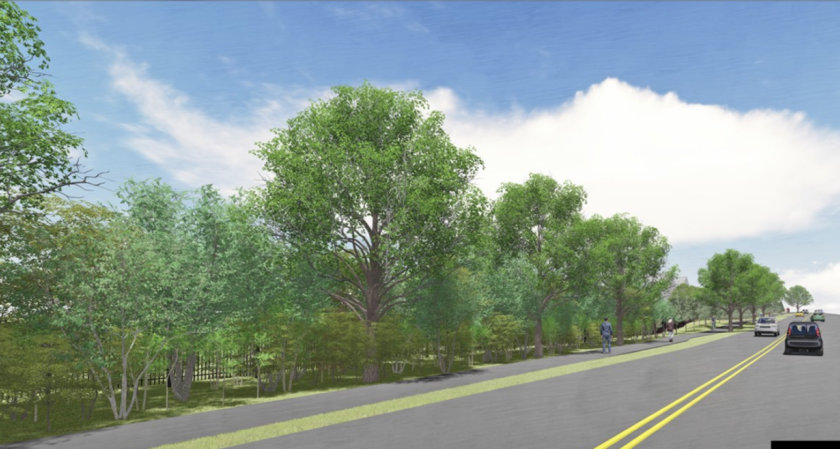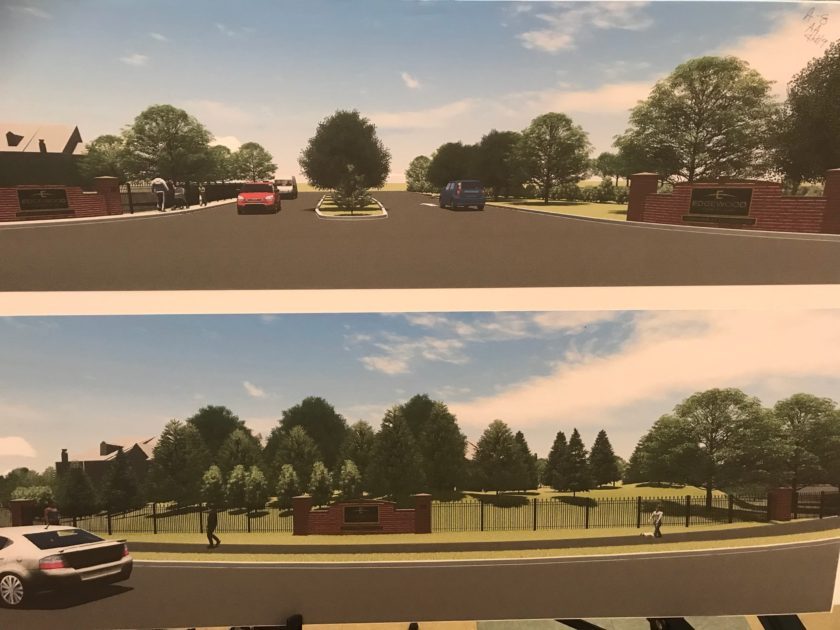
RIVER VALE, N.J.—After an attorney for residents once opposing its construction withdrew all objections, Joint Planning Board members agreed May 29 to ask for a resolution to approve a 249-unit townhome development on Edgewood Country Club—including 24 affordable units—to be voted on at the June 19 regular meeting.
The agenda has three additional applications for the board to take up.
Following testimony from an applicant planner concluding Woodmont Properties’ expert witnesses, attorney Jameson Van Eck, of Verde, Steinberg Pontell LLC, Hackensack—who represented owners of 107 townhomes at nearby River Vale at Holiday Farm Condominium Association—led off the public session by announcing the townhome owners would no longer oppose the project.
Van Eck said the Holiday Farm association’s trustees “are comfortable” with revised plans submitted on April 11 and May 15 “and did not reach this decision lightly…in light of these modifications …Holiday Farm does support the applicant in obtaining its approval for this project,” Van Eck said.
Van Eck said “the alternatives for this site could have been worse” including full development of the former 27-hole golf course, or even a more dense development of nine holes that are used for the Fairways at Edgewood development. Van Eck called the development “a way to provide affordable housing, avoid litigation and preserve 18 of 27 holes of the golf course.”
“No development is without its critics or its downsides,” said Van Eck, noting River Vale’s need to fulfill its affordable housing obligations made that “an unviable outcome.”
He said the proposal helps the township to “balance the need for affordable housing with the need to protect its citizens from builder’s remedy lawsuits.”
“A win today by blocking this development could result in a loss tomorrow by a court-ordered development of the entire course,” Van Eck said.
He said the opponents got “many modifications” due to citizen input, including increases in buffer areas by the affordable housing and maintenance buildings on Piermont Avenue, reduced elevations of the affordable housing building, and improved aesthetics of the affordable housing complex; moved the trash enclosures away from Piermont Avenue; and reduced light illumination levels to minimize impacts on Holiday Farm.

‘Planning process worked’
“In this case the planning process worked—again, we did not come to this decision lightly, but instead after consideration of all applicable facts and legal circumstances. As noted we hereby withdraw our objection,” he noted, calling the proposal a compromise.
The controversial application’s seventh hearing, May 29, also featured testimony on Woodmont Properties’ proposal from its final witness, planner Christine Nazzaro Cofone of Red Bank, who discussed in detail the applicant’s position on variances requested.
She said that many variances sought—including fence height, number of complex signs, and height of maintenance buildings used to house golf course equipment—should be granted due to statutory criteria which allow them as well as aesthetics and efficiency of site operations.

Residents speak out
Since hearings began in January—when the first hearing in Holdrum School’s gym drew nearly 150 residents—attendance has declined at subsequent hearings with about 20 residents on hand May 29 when final public comments and opinions were allowed. At previous hearings, residents were only allowed to ask questions on experts’ testimony, not offer personal opinions or commentary.
The final public comment session, which permitted residents to get in personal opinions and criticisms not permitted during testimony offered at regular hearings, was concluded with about six residents stating objections to the development
“I know this all has to be done I know you have to fulfill the needs of COAH housing,” said Rivervale Road resident Stephanie Muska.
She added, “You’re taking this area in the center of our town and you’re filling it so it’s going to look different than the rest of the town.” She called the development “squished-together housing.”
She said Fairways “is not going to be a welcoming community” and that “This is going to be closed off. This is an area that’s going to have a big sign that reads: You’re not welcome here because we are our own community within your community.”
Muska said the deal was not done yet “to make this the elite, the golf course, the special community” and objected to increased imperviousness at the 249-unit development.
“That’s not right to pass something like that,” she said. With encouragement from the audience, she added, “I don’t think it’s necessary to have something like this. You’ve gone from A-1 or 1-acre lots to… I don’t even know what this is called—I don’t know the exact lot size—but it’s certainly not 1-acre lots.”
She added, to applause, “I know it has to be done but it certainly doesn’t have to be done like this.”
Resident John Vidral said he was concerned about increased traffic at Piermont Avenue and Rivervale Road and that he hoped a traffic light would be installed there “because it’s going to be very dangerous for pedestrians and crossing guards.”
He said it was “a shame” that more legislators were not pushing against affordable housing obligations being forced on municipalities.
“We’re stuck right now and I believe the mayors and others have done a good job trying to limit the impact of COAH upon us,” Vidral said.
He urged residents to consider candidates’ views on affordable mandates.
Resident Lisa Quinn said members were “supposed to be working for us, I don’t feel you are working for us” and that the affordable housing complex was put where it was “because you don’t want to interrupt the flow of the townhouses.”
She said the Fairways development would put a “minimum of 500 more cars on the road” and charged the development is “just ruining the character of the whole town” and suggested putting the affordable units near other such units being built by the senior and community center.
James D’Alessandro wondered “why the COAH building could not be better integrated” into the Fairways development, charging it was located “in its own segregated area” instead of the southeast corner.
He wondered why no such alternatives were suggested by the applicant or brought up by the board.
He said the affordable units should be better integrated in Fairways and into River Vale. He further wondered whether any state laws on affordable housing applied to a separate affordable complex.
D’Alessandro said he heard no testimony on impacts on Holdrum Brook and called the environmental impact report “ludicrous on its face” because it cited Canada geese and deer.
He said he did not hear “a shred of testimony” on environmental impacts, no testimony on detention basin maintenance, and “incomplete” testimony on traffic impacts from an applicant traffic consultant.
He questioned “the underlying science” of detention basin management and questioned the board members’ “deference” to the applicant engineer’s testimony.
‘The impacts downstream’
Kira McKeown-Adamo said she was concerned about Holiday Farm residents who repeatedly expressed fears of being flooded and recommended hiring an independent engineer “to find out the impacts downstream of what the new retention pond will be.”
She questioned why the architect testified that no site analysis was done for the project. “He didn’t even do his due diligence,” she noted.
Piermont Avenue resident Nancy Liguori cited a lack of storm sewers along Piermont and questioned whether storm sewers will be installed to catch storm runoff.
Borough Engineer Christopher Statile said the issue was raised and resolved with county engineers and will be addressed by them.
Board chair Scott Lippert said, “We’re not going to vote on anything unless we have final, final, final plans.”
He said unless all changes were made on the final plans to be voted on by June 19 then the board might not take a final vote at that time.
However, the board could consider a vote on having a final plan in hand by the time a developer’s agreement is signed between the township and developer, said board attorney Marc Leibman.
Leibman said he probably needed 30 days to draft a resolution of approval for the board’s consideration, although he agreed to try to produce a resolution by June 19.
“We’ll do what we can do,” Lippert said.
Leibman said the resolution would include all the conditions and variances discussed during previous hearings and that he would set up the resolution so members could vote on individual variances being requested by the developer.
